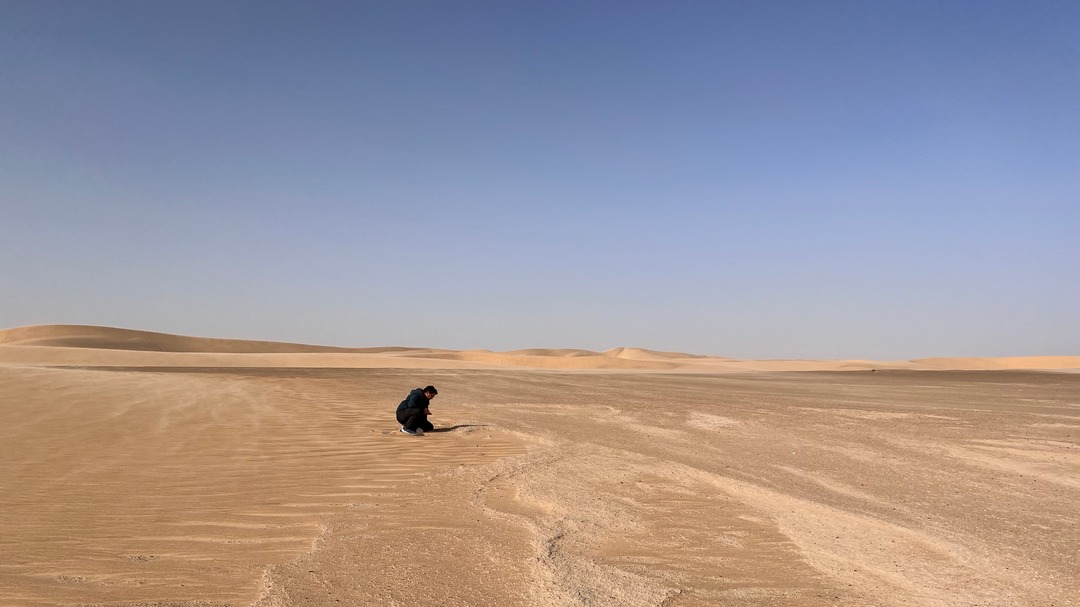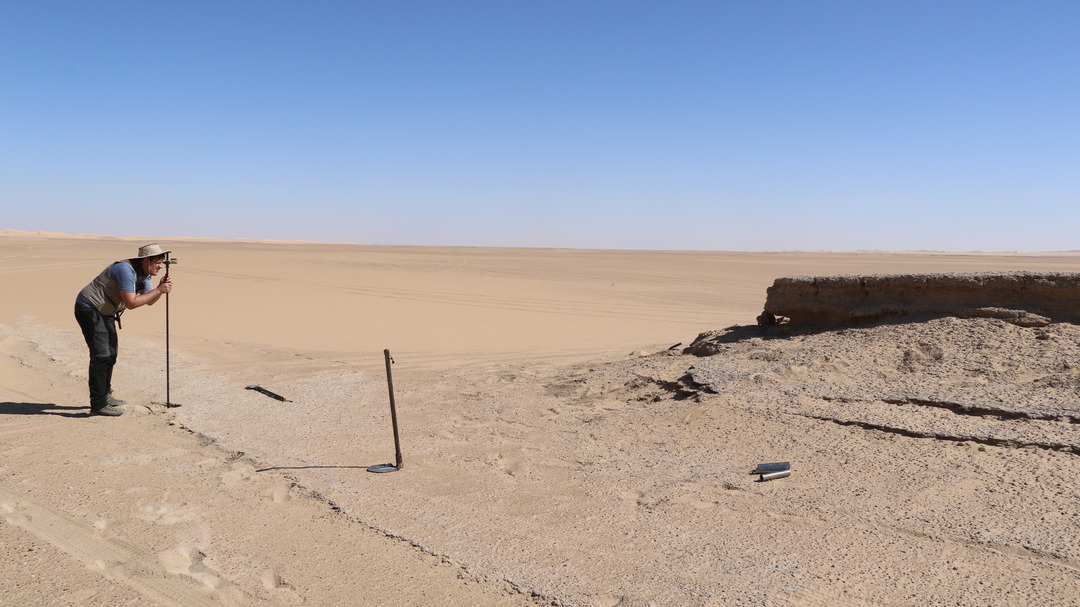KAUST research shows the lush past of the world’s largest desert, Rub’ Al-Khali

The Rub’ Al-Khali desert with two cars that brought the researchers
New research from KAUST and international collaborators reveals the Arabian region was once home to a vast lake and river system
The formation of grasslands and savannahs facilitated human expansion across the Arabian Peninsula
This narrative of climate perturbations and human migrations, written in rocks and landscapes, is fundamental to understanding and predicting the possible consequences of current climate change
The Empty Quarter (Rub’ al-Khali), the vast desert of the Arabian Peninsula, was not always a barren landscape. A recent study by King Abdullah University of Science and Technology (KAUST), the University of Geneva (UNIGE), Griffith University in Australia, California Institute of Technology, University of Texas, and University of the Fraser Valley in Canada reveals that this region was once home to a vast lake and river system.
These favorable conditions fostered the growth of grasslands and savannahs, enabling human migration — until drought returned, forcing populations to relocate. Published in Communications Earth & Environment and led by KAUST Professor of Geology Abdulkader M. Afifi, along with his research scientists Antoine Delaunay and Guillaume Baby at KAUST and with Abdallah Zaki of the University of Geneva, this research highlights the impact of climate cycles on landscapes and human societies. The Empty Quarter, also known as Rub’ al-Khali in Arabic, is one of the world’s largest deserts. Spanning nearly 650,000 square kilometers, primarily in Saudi Arabia, it dominates the Arabian Peninsula, with dunes that tower up to 250 meters. Yet, this vast arid expanse was not always so inhospitable.
“Beneath Rub’ al Khali’s desolate sands lies a vibrant past of lakes and rivers,” says Antoine Delaunay. “Our study highlights the transformative power of the climate on Arabian landscapes and their profound connection to human occupation; further investigation is crucial to unraveling these complex interactions."

A member of the research team looking at sediments from an 8000-year-old lake.
A 42-metre-deep lake
These water sites emerged during the ‘‘Green Arabia’’ period, a time of heavy rainfall that lasted from approximately 11,000 to 5,500 years ago, at the end of the Quaternary era. The lake is estimated to have been vast, covering an area of 1,100 km²and reaching a depth of 42 meters. As rainfall increased, the lake eventually overflowed, causing a significant flood that carved a 150 km-long valley into the desert floor.
Based on sediments and landforms traced over 1000 km, scientists believe that the heavy rains feeding these ancient waterholes came from the northward expansion of the African and Indian monsoons. These wet phases, linked to orbital cycles, varied in duration depending on the region: lasting several millennia in the south compared to only a few centuries in the north. They favored the formation of grasslands and savannahs, which in turn facilitated human expansion across the Arabian Peninsula.
This study is part of an effort by KAUST scientists to understand the interplay between climate, landscape, environment, and human habitation in the Arabian Peninsula. An international team led by KAUST Professor Frans Van Buchem is also studying ancient lakes in Wadi Ad Dawasir and their impact on human occupation near the UNESCO World Heritage settlement at Al Faw.

A member of the research team measuring the extent and width of old river channels that were used to model the landscape before the great acidification event.
Human Impact
‘‘The formation of lake and river landscapes, along with grasslands and savannahs, would have facilitated the expansion of hunting, gathering, and pastoral groups into what is now a dry, barren desert. This is confirmed by abundant archaeological evidence found in the Empty Quarter and along its ancient lake and river systems,’’ says Michael Petraglia, a professor of archaeology at Griffith University’s Australian Research Centre for Human Evolution. Approximately 6,000 years ago, the region experienced a sharp decline in rainfall, resulting in dry, arid conditions that compelled these nomadic populations to migrate to more hospitable environments.
These findings highlight the pivotal role of the African monsoon in the rapid transformation of the Arabian Peninsula’s desert landscape, as well as in shaping population movements. This narrative of climate perturbations and human migrations, written in rocks and landscapes, is fundamental to understanding and predicting the possible consequences of current climate change.

